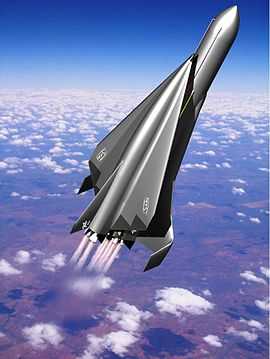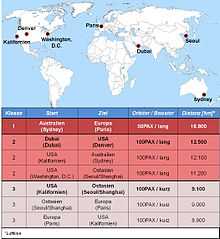SpaceLiner
 Artist's impression of the SpaceLiner 7 during ascent | |
| Function | Hypersonic passenger transport |
|---|---|
| Country of origin | |
SpaceLiner is an advanced concept for a suborbital, hypersonic, winged passenger transport, which is currently under investigation at the German Aerospace Center (Deutsches Zentrum für Luft- und Raumfahrt, or DLR) since 2005.[1]
The DLR projected that, if funded and development is continued, it could field an operational spaceplane in the 2040s.
Concept
The two-stage, vertical-takeoff configuration concept consists of a large unmanned booster and a manned stage designed for 50 passengers and 2 crew members. The fully reusable vehicle is accelerated by a total of eleven liquid rocket engines (9 for the booster, 2 for the passenger stage), which are to be operated using cryogenic liquid oxygen (LOX) and hydrogen (LH2). After engine cut-off, the orbiter stage is to enter a high-speed gliding flight phase and be capable of traveling long intercontinental distances within a very short time. Altitudes of 80 kilometers and Mach numbers beyond 20 are projected, depending on the mission. Flight times of the SpaceLiner from Australia to Europe should take just 90 minutes or no more than 60 minutes on the Europe- California route.[2] Acceleration loads for the passengers on these missions are designed to remain below those of the Space Shuttle astronauts with a maximum of 2.5 g being experienced during the propelled section of the flight.
The concept design also foresees the passenger cabin to function as an autonomous rescue capsule which can be separated from the vehicle in case of an emergency, allowing the passengers to return safely to Earth. According to DLR information, the commissioning of a first operational system should be possible between 2040 and 2050. A key aspect of the concept is its full reusability and vehicle mass-production which closely resembles that of the aviation industry. Consequently, it is expected to deliver a significant increase in cost effectiveness compared to the space transportation systems of the early 2000s. A major challenge lies in improving the security and reliability of space components such as rocket engines, so that they will become suitable for the daily operation of a passenger transport like SpaceLiner.
Currently, the development of the concept is funded by DLR's internal resources, as well as in the context of EU-FP7 funded projects such as Fast 20XX and CHATT. In addition to DLR, various partners from the European aerospace sector are involved.

Previous development
As of November 2011, the SpaceLiner was in a preliminary design phase, and research was ongoing to further this status. Based on the results of previous work, the development is continuously progressing, with increasingly detailed and in-depth considerations of the various subsystem development and integration. Some variants with different requirements and specifications were studied with associated results influencing and redirecting the entire design process.[3]
SpaceLiner 2 refers to the first version, which featured the integration of an innovative active cooling system [4] for the areas of particularly high thermal stresses during atmospheric, re-entry, being the nose and wing leading edge sections.
The SpaceLiner 4 is an evolution of the version 2 with improved aerodynamic and flight dynamic characteristics. Based on this configuration, various technologies necessary for the SpaceLiner were experimentally and numerically examined, research that was funded by the EU research project FAST20XX.[5]
The current and latest configuration under investigation at the DLR is the SpaceLiner 7.[6] Based on results obtained from application of numerical optimization methods which achieved an improvement of the aerodynamic, thermal and structural-mechanical properties in hypersonic flight, the initial double delta wing of previous versions has been modified and replaced by a single delta wing. Currently, subsystems such as the passenger cabin, the cryogenic tanks, the propellant feed system and the vehicle thermal protection [7] have been preliminarily designed and integrated.

Possible routes for the SpaceLiner have been classified and grouped in terms of their distances, with class 1 being the longest and class 3 describing the shortest still economically interesting and relevant distance. In line with this, most recently a modified version of the SpaceLiner 7 capable of flying medium long-haul distances while carrying 100 passengers has been examined. Given the name SL7-100, this concept variant is suitable for class 2 and class 3 distance flights.[8] To accommodate for the different SpaceLiner configurations, a long and short version of the booster stage have therefore been considered to accordingly fulfill the mission requirements depending on the required range, either in combination with the 50 or 100-passenger stage version.
Technical data

The specifications of at least one version of the SpaceLiner are:
| Parameters | Passenger Stage (50 passenger version) |
Booster (long version) |
Total (Australia–Europe mission) |
|---|---|---|---|
| Overall length: | 65.0 m | 83.5 m | |
| Wing span: | 33.0 m | 37.5 m | |
| Overall height: | 12.0 m | 8.6 m | 21.5 m |
| Cabin length: | 15.3 m | - | |
| Max. fuselage diameter: | 6.8 m | 8.6 m | |
| Empty mass: | 145 t | 170 t | 315 t |
| Total mass: | 380 t | 1460 t | 1840 t |
| Propellant mass: | 215 t | 1285 t | 1500 t |
| MECO mass: | 160 t | 180 t | |
| Max. altitude: | approx. 80 km | approx. 75 km | |
| Max. speed: | 7 km/s (25,200 km/h) | 3.7 km/s (13,300 km/h) | |
| Max. Mach number: | 24 | 14 | |
| Max. range: | up to about. 18,000 km | ||
| Number of engines: | 2 | 9 | 11 |
Propulsion
The SpaceLiner concept intends to use a single type of reusable liquid rocket engine, which operates in the full-flow staged combustion cycle mode.[9] The nozzle expansion ratio is adapted to the different missions of the booster and passenger stages. Furthermore, liquid hydrogen and liquid oxygen will be used as the propellants, a combination which is both very powerful while remaining eco-friendly.
| Characteristics | Passenger Stage |
Booster |
|---|---|---|
| Mixture ratio: | 6.0 | |
| Combustion chamber pressure: | 16.0 MPa | |
| Mass flow rate (per engine): | 518 kg/s | |
| Expansion ratio: | 59.0 | 33.0 |
| Specific impulse (vacuum): | 449 s | 437 s |
| Specific impulse (sea level): | 363 s | 389 s |
| Thrust per engine (vacuum): | 2268 kN | 2206 kN |
| Thrust per engine (sea level): | 1830 kN | 1961 kN |
External links
| Wikimedia Commons has media related to Category:. |
- To Australia in 90 minutes at hypersonic speed (blog) (video), DE: DLR.
- "The SpaceLiner", You tube (video), Google.
- Sippel, Dr Martin (2012), "Interview", DLR (Google You tube) (video), Berlin: ILA
- "Technical characteristics of SpaceLiner SL7, status", You tube, Google, September 2012.
- "FAST20XX", Space engineering, ESA.
- "DLR studies suborbital space travel", Flight global, Jul 18, 2006.
References
- ↑ Sippel, M; Klevanski, J; Steelant, J (October 2005), "Comparative study on options for high-speed intercontinental passenger transports: air-breathing- vs. rocket-propelled", IAC-05-D2.4.09.
- ↑ Sippel, M (Jun–Jul 2010), "Promising roadmap alternatives for the SpaceLiner", Acta Astronautica 66 (11–12): 1652–58, doi:10.1016/j.actaastro.2010.01.020, retrieved 2011-02-15
- ↑ Schwanekamp, T; Bauer, C; Kopp, A. "Development of the SpaceLiner Concept and its Latest Progress" (PDF; 1672 kB). 4th CSA-IAA Conference on Advanced Space Technology, September 2011. DE: DLR. Retrieved 2013-05-10.
- ↑ van Foreest, A; et al, "Transpiration Cooling Using Liquid Water" (PDF; 29 kB), Journal of Thermodynamics and Heat Transfer (AIAA) 23 (4), retrieved 2011-02-15
- ↑ van Foreest, A (2009). "The Progress on the SpaceLiner Design in the Frame of the FAST 20XX Program" (PDF; 138 kB). 16th AIAA/DLR/DGLR International Space Planes and Hypersonic Systems and Technologies Conference. AIAA. Retrieved 2011-02-15.
- ↑ M. Sippel, T. Schwanekamp, O. Trivailo, A. Lentsch. "Progress of SpaceLiner Rocket-Powered High-Speed Concept" (PDF; 2370 kB). IAC 2013. IAF. Retrieved 2014-04-24.
- ↑ Garbers, N (2023). "Overall Preliminary Design of the Thermal Protection System for a Long Range Hypersonic Rocket-Powered Passenger Vehicle (SpaceLiner)" (PDF; 138 kB). 7th European Workshop on Thermal Protection Systems and Hot Structures. Retrieved 2014-04-24. Check date values in:
|date=(help) - ↑ T. Schwanekamp, J. Bütünley, M. Sippel. "Preliminary Multidisciplinary Design Studies on an Upgraded 100 Passenger SpaceLiner Derivative" (PDF; 2370 kB). 18th AIAA/3AF International Space Planes and Hypersonic Systems and Technologies Conference. 2012. Retrieved 2013-05-10.
- ↑ Sippel, M; et al (2012). "Technical Maturation of the SpaceLiner Concept". 18th AIAA/3AF International Space Planes and Hypersonic Systems and Technologies Conference. AIAA. Retrieved 2013-04-22.